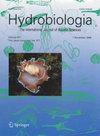Seasonal and spatial variability of the euphotic zone in Bahía de Banderas
IF 0.3
4区 生物学
Q4 MARINE & FRESHWATER BIOLOGY
引用次数: 0
Abstract
Background. The euphotic zone (EUZ) is the most superficial section of the water column where solar radiation is sufficient to produce photosynthesis. In situ depth is measured using light profiler probes but can also be monitored using remote sensing. Objective. To determine the temporal and spatial variability of Bahía de Banderas Euphotic Zone (EUZ) and its relationship with other variables that contribute to turbidity. Methods. Different data sources (OceanColor, Copernicus, NOAA, CONAGUA) were used to obtain time series (2003 to 2020) of particulate inorganic matter (PIM), Chlorophyll-a (Chl-a), diffuse attenuation coefficient at 490 nm (Kd490), depth of the Secchi disk (ZSD), ZEU, daily precipitation and water level of the Ameca and Pitillal rivers and a correlation analysis was made between these variables, and a cluster analysis to determine if there are spatial differences in the bay, as well as scatter plots to observe trends among environmental parameters. Two seasonal maps (rainy and dry season) were drawn based on the climatic medians of ZEU and the prevailing geostrophic currents. Results. The euphotic zone (EUZ) was deeper from June to August (48.54 ± 21.93 m) and shallower from February to April (22.95 ± 12.98 m); the cluster analysis determined that the bay is divided into two areas: the north, whose ZEU is shallower (higher correlation with MIP and Chl-a), and the south, where it is deeper (higher correlation with Chl-a). Conclusions. The parameter that has the greatest effect on the depth of the ZEU is the Chl-a, and only the area closest to the mouth of the Ameca and Pitillal rivers presents an inverse relationship between the ZEU with the MIP and the Chl-a.Bahía de Banderas光区的季节和空间变异
背景。光带(EUZ)是水柱最浅层的部分,在这里太阳辐射足以产生光合作用。就地深度是用光剖面探测器测量的,但也可以用遥感监测。目标。确定Bahía de Banderas EUZ (de Banderas EUZ)的时空变异性及其与其他浊度变量的关系。方法。利用不同数据源(OceanColor、Copernicus、NOAA、CONAGUA)获取2003 - 2020年Ameca和Pitillal河流颗粒无无机物质(PIM)、叶绿素-a (Chl-a)、490 nm扩散衰减系数(Kd490)、Secchi盘深度(ZSD)、ZEU、日降水量和水位的时间序列,并对这些变量进行相关分析,并进行聚类分析,确定海湾内是否存在空间差异。以及散点图来观察环境参数之间的趋势。根据ZEU的气候中值和当时盛行的地转流绘制了两幅季节图(雨季和旱季)。结果。6 ~ 8月的EUZ较深(48.54±21.93 m), 2 ~ 4月的EUZ较浅(22.95±12.98 m);聚类分析确定海湾分为两个区域:北部,其ZEU较浅(与MIP和Chl-a的相关性较高),南部,其较深(与Chl-a的相关性较高)。结论。对ZEU深度影响最大的参数是Chl-a,只有最靠近美洲河和皮蒂勒河入海口的区域ZEU与MIP和Chl-a呈反比关系。
本文章由计算机程序翻译,如有差异,请以英文原文为准。
求助全文
约1分钟内获得全文
求助全文
来源期刊

Hidrobiologica
生物-海洋与淡水生物学
CiteScore
0.40
自引率
0.00%
发文量
8
审稿时长
>12 weeks
期刊介绍:
HIDROBIOLÓGICA es una publicación cuatrimestral que difunde trabajos originales e inéditos de investigación o revisión, sobre temas relacionados con los organismos y la hidrología de los ambientes acuáticos, dulces y marinos y va dirigida a investigadores de todo el mundo, interesados en las diversas disciplinas que incluye la Hidrobiología , así como a alumnos de posgrados y licenciaturas relacionados con la biología, ecología, taxonomía, filogenia y evolución de organismos acuáticos, e hidrología y oceanografía de ambientes s dulceacuícolas y marinos.
 求助内容:
求助内容: 应助结果提醒方式:
应助结果提醒方式:


